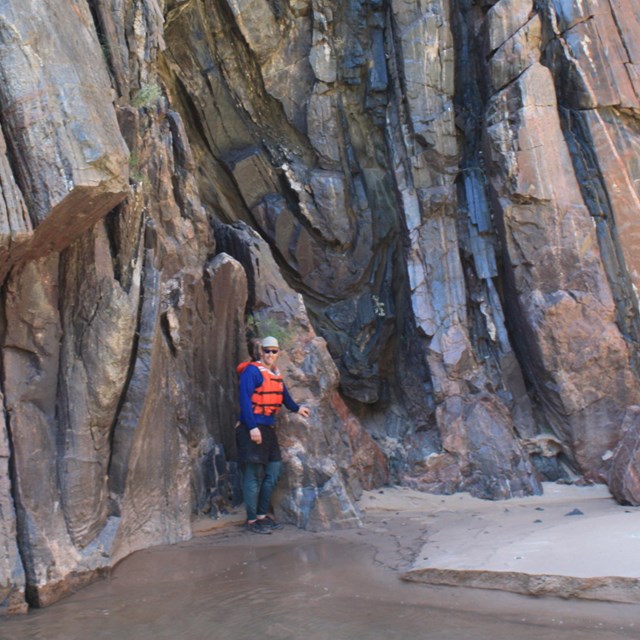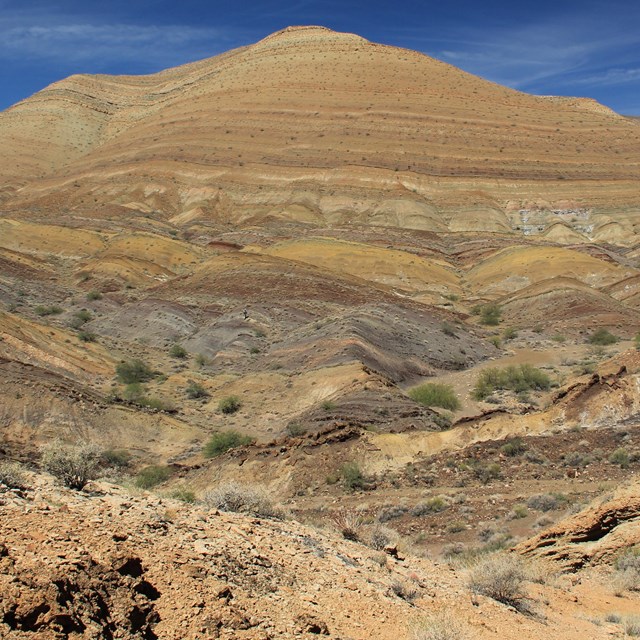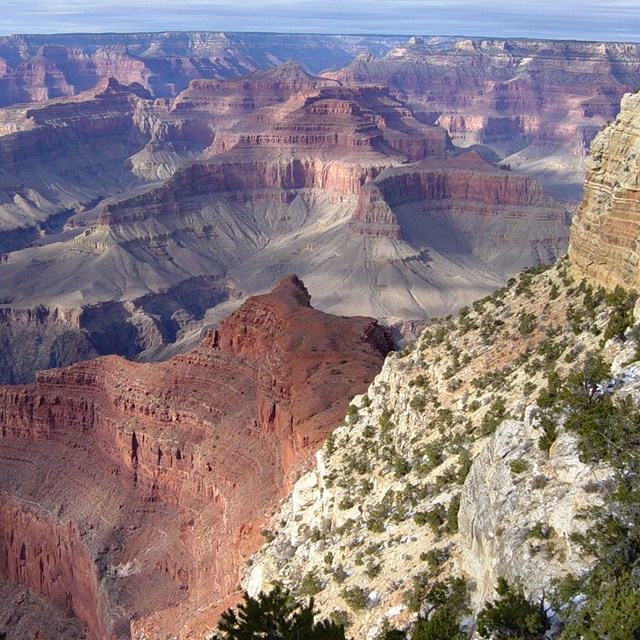Part of a series of articles titled Telling Time at Grand Canyon National Park.
Article
Numeric Ages of Grand Canyon Rocks
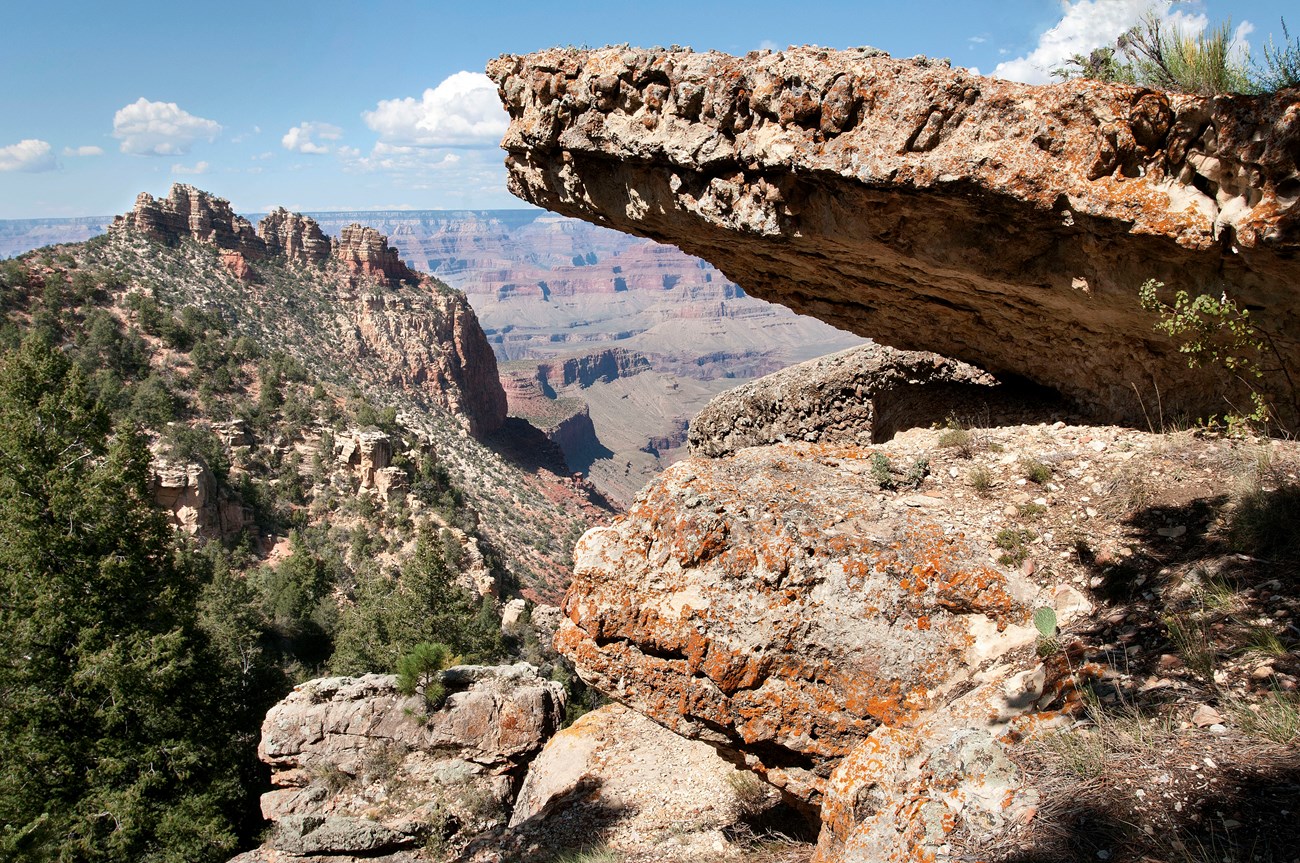
NPS photo.
Introduction—The Need for Numeric Ages
When someone’s objective is simply to learn how old a rock layer is, sorting through the technical geologic literature, the subdivisions of geologic periods, and the scientific names of microscopic index fossils, can be confusing. Most non-geoscientists will find a description of the Kaibab Formation as from the Permian Period not particularly meaningful, much less a description that involves a more specific fossil stage. Moreover, the intricacies of how geologists tell time by using both relative and radiometric dating techniques can add to the complexity.
Nevertheless, people generally understand a numeric age, such as the Kaibab Formation being 270 million years old. Therefore, numeric ages are essential when communicating geology to the public and to one another.
But finding such numbers in the scientific literature is not always easy. Some studies report only the stratigraphic age or the broad geologic era or period of a rock unit and do not use numeric ages, see Geologic Timescale and Geologic Dating Techniques. Moreover, scientific papers that do publish radiometric age determinations are not always clear about the geologic significance of these dates. For example, a radiometric date on zircon crystals found in an igneous rock measures the time when the rock (and the zircons within it) crystallized. But dates on zircon grains found within a sedimentary rock only provide a maximum age for the sedimentary rock since the grains themselves crystallized in an older igneous rock that was eroded to become a sediment source. Grains within a sedimentary rock inherently must be older than the rock itself.
Unfortunately, telling geologic time seems mysterious to many people without backgrounds in Earth science. Naturally, a non-geoscientist may wonder, “How do you know that?” when a geologist or park interpreter says, “That rock formed 270 million years ago.” To add to the confusion, both technical and popular literatures report a wide variety of numeric ages for Grand Canyon rocks. Further, popular accounts may not always utilize the most current research. For example, one publication may say that the Kaibab Formation is 270 million years old, while another says 255 million years old. The same inconsistencies arise for the other rock units in the park. People may be left wondering which are the correct (or best) ages and why. At worst, they may discount the scientific methods used to measure deep time. Geologists know that these changes reflect the scientific process itself. Scientists continually apply new research, dating methods, and critical analysis of previously published works to refine the understanding of the age of rock units.
Best Numeric Ages for Grand Canyon Rocks
This compilation of best numeric ages for Grand Canyon rocks serves important scientific purposes, particularly given ongoing research into the age of Grand Canyon rocks, the difficulty in determining the ages of many rock units, and Grand Canyon’s geologic significance.
The goal of this compilation is to provide a single list of updated numeric ages that users could apply consistently, thereby facilitating better comprehension of the geologic history and features of Grand Canyon. Research moves forward and the scientific excitement of obtaining new knowledge about old rocks is an important part of Grand Canyon’s geologic story.
These best ages still have limitations and are approximations in some ways given the complexities of how rocks form through time, and are subject to revision as our understanding of Grand Canyon geologic history improves.
The constraints on determining the best ages for each rock unit include the inherent limitations of the dating techniques used, the availability of datable material and/or fossils present in each rock unit, and the quality and quantity of relevant geological observations. In turn, scientific understanding of Grand Canyon geology and how dating techniques are used to obtain the age of rocks are part of the expert opinion also needed to ascertain the best numeric values.
| Rock Set | Group | Formation | Stratigraphic Age | Numeric Age (Ma) |
| Layered Paleozoic Rocks | – | Kaibab Formation | Early Middle Permian | 270 |
| – | Toroweap Formation | Late Early Permian | 275 | |
| – | Coconino Sandstone | Early Permian | 280 | |
| – | Hermit Formation | Early Permian | 285 | |
| Supai Group | Esplanade Sandstone | Early Permian | 290 | |
| Wescogame Formation | Late Pennsylvanian | 300 | ||
| Manakacha Formation | Early Pennsylvanian | 315 | ||
| Watahomigi Formation | Early Pennsylvanian | 320 | ||
| – | Surprise Canyon Formation | Late Mississippian | 325 | |
| – | Redwall Limestone | Late Early – Middle Mississippian | 340 | |
| – | Temple Butte Formation | Middle – Late Devonian | 385 | |
| Tonto Group | Frenchman Mountain Dolostone | Late Middle Cambrian | 500 | |
| Muav Formation | Late Middle Cambrian | 504 | ||
| Bright Angel Formation | Middle Cambrian | 506 | ||
| Tapeats Sandstone | Middle Cambrian | 508 | ||
| Sixtymile Formation | Early Middle Cambrian | 510 | ||
| Grand Canyon Supergroup | Chuar Group | Kwagunt Formation Walcott Member | Neoproterozoic | 729 |
| Kwagunt Formation Awatubi Member | Neoproterozoic | 750 | ||
| Kwagunt Formation Carbon Butte Member | Neoproterozoic | 753 | ||
| Kwagunt Formation Duppa Member | Neoproterozoic | 755 | ||
| Galeros Formation Carbon Canyon Member | Neoproterozoic | 757 | ||
| Galeros Formation Jupiter Member | Neoproterozoic | 765 | ||
| Galeros Formation Tanner Member | Neoproterozoic | 770 | ||
| Nankoweap Formation | Mesoproterozoic | 775 | ||
| Unkar Group | Cardenas Basalt | Mesoproterozoic | 1,082 | |
| Dox Formation | Mesoproterozoic | 1,120 | ||
| Shinumo Sandstone | Mesoproterozoic | 1,130 | ||
| Hakatai Shale | Mesoproterozoic | 1,230 | ||
| Bass Formation | Mesoproterozoic | 1,255 | ||
| Bass Formation Hotauta Conglomerate Member | Mesoproterozoic | 1,255 | ||
| Vishnu Basement Rocks | Youngest granite | Quartermaster granite | Mesoproterozoic | 1,375 |
| Later granites / dike swarms | Phantom granite | Paleoproterozoic | 1,662 | |
| Cremation pegmatite | Paleoproterozoic | 1,698 | ||
| Zoroaster Plutonic Complex | Horn Creek granite | Paleoproterozoic | 1,713 | |
| Ruby gabbro | Paleoproterozoic | 1,716 | ||
| Trinity granite | Paleoproterozoic | 1,730 | ||
| Diamond Creek granite | Paleoproterozoic | 1,736 | ||
| Zoroaster granite | Paleoproterozoic | 1,740 | ||
| Granite Gorge Metamorphic Suite | Vishnu Schist | Paleoproterozoic | 1,750 | |
| Brahma Schist | Paleoproterozoic | 1,750 | ||
| Rama Schist | Paleoproterozoic | 1,751 | ||
| Oldest basement | Elves Chasm pluton | Paleoproterozoic | 1,840 |
Ma = mega annum = million years ago
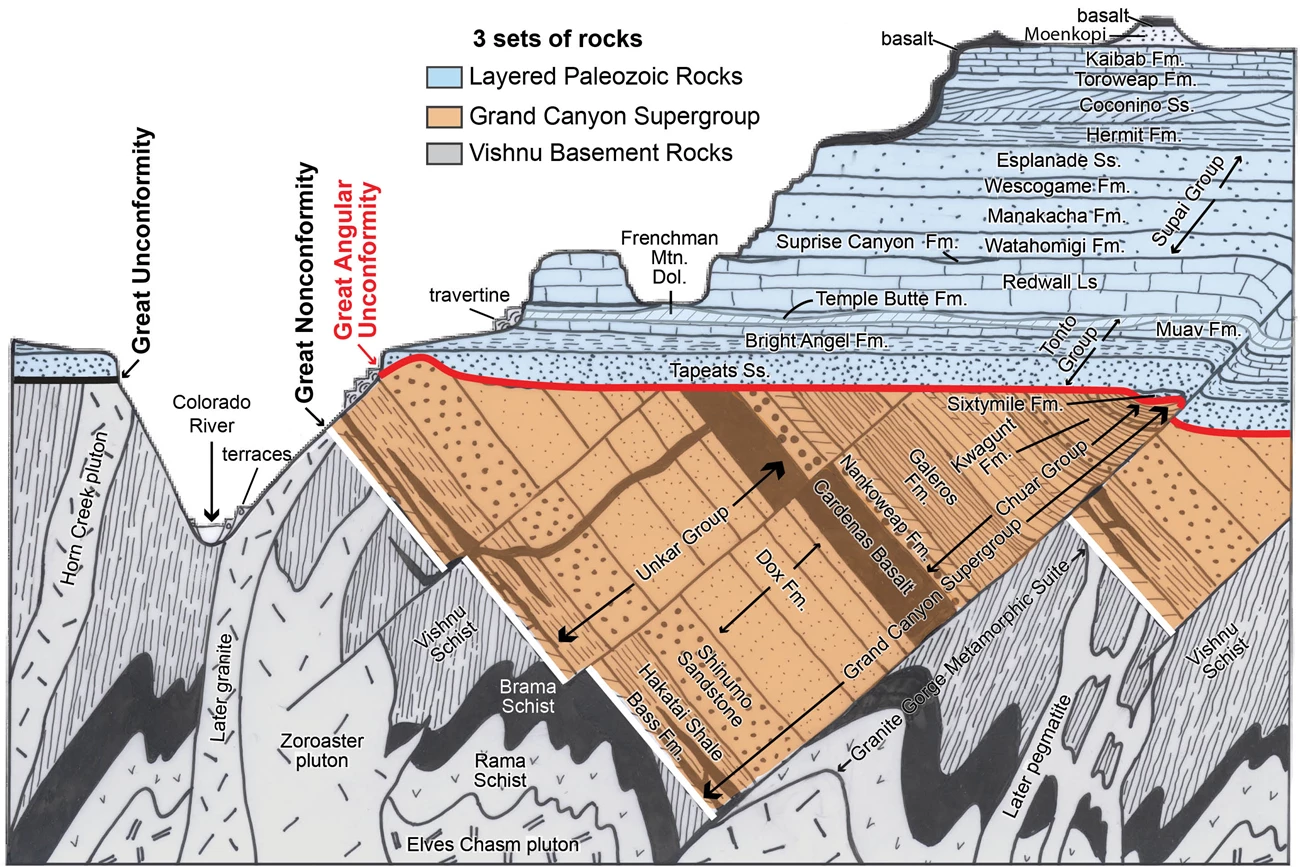
Angular Unconformity (red line) and Great Unconformity (black line). Fm = Formation; Ss = Sandstone; Ls = Limestone.
Complexities Related to the Geologic Meaning of Numeric Ages
The Elves Chasm pluton at 1,840 Ma (mega annum; million years old) is the oldest dated rock in Grand Canyon. The precision of this analytical measurement is within one million years; in other words, scientists are 95% sure that if they dated these same grains repeatedly using the same method (uranium-lead on zircon crystals), we’d get an age within a million years either side of 1,840 Ma. The accuracy of this date depends on not just the dating method, but also anything that may have happened to the grains to partially reset their geologic clock after crystallization. Fortunately, zircon crystals contain two different uranium isotope parents that decay at different rates to two different lead isotope daughters so that a single grain gives two independent dates that cross-check each other to produce highly accurate and precise ages.
But outcrops of the Elves Chasm pluton are geologically complex. Figure 9 shows that dark inclusions were surrounded by and hence are older than the main Elves Chasm magma, then both were cross-cut by younger dikes. Thus, for full disclosure, only the main magma body crystallized 1,840 ± 1 million years ago, not the older inclusions or the younger dikes.
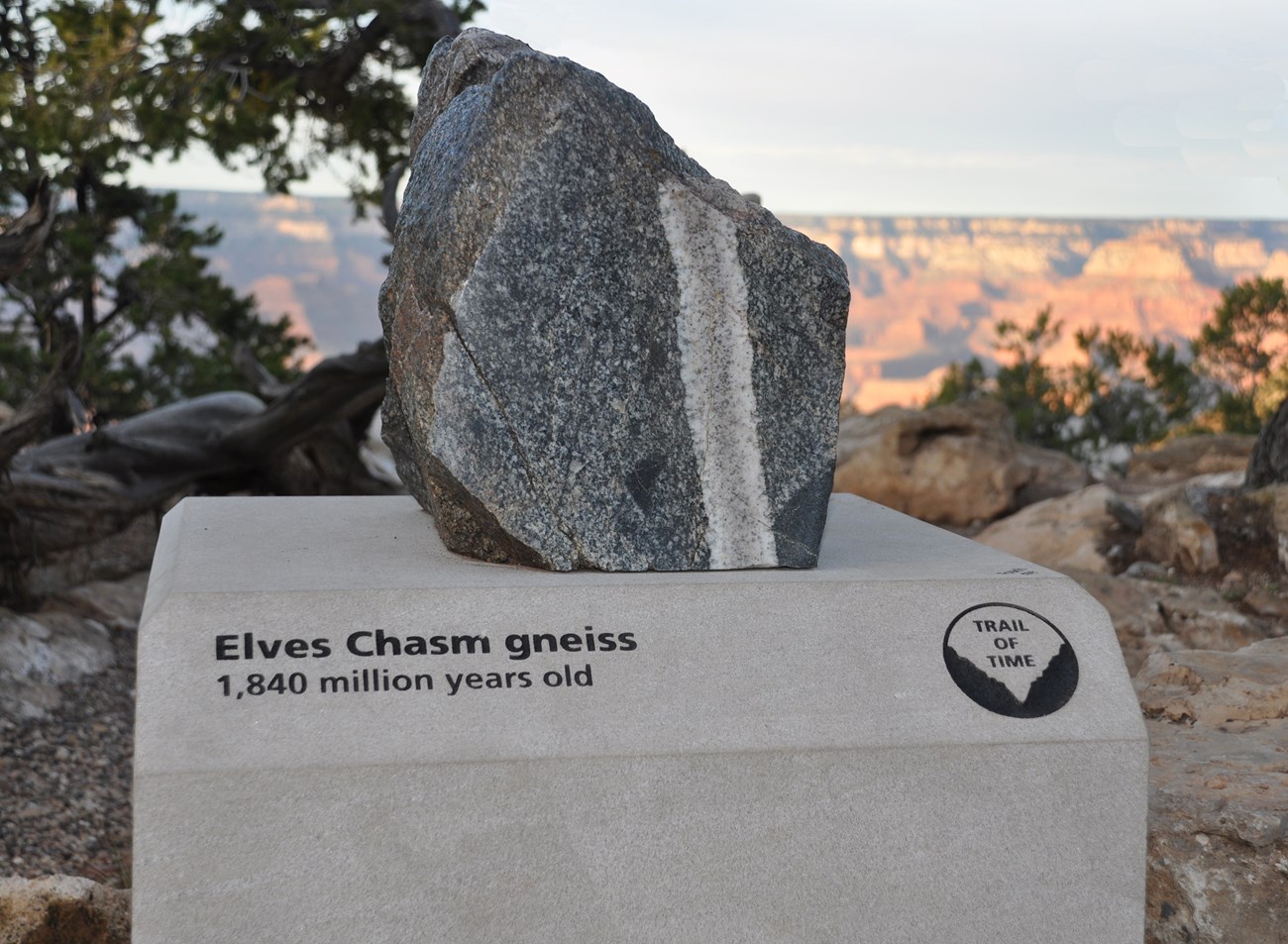
Figure 9a. Specimen of the Elves Chasm pluton on the Trail of Time.
MPS photo by Michael Quinn.
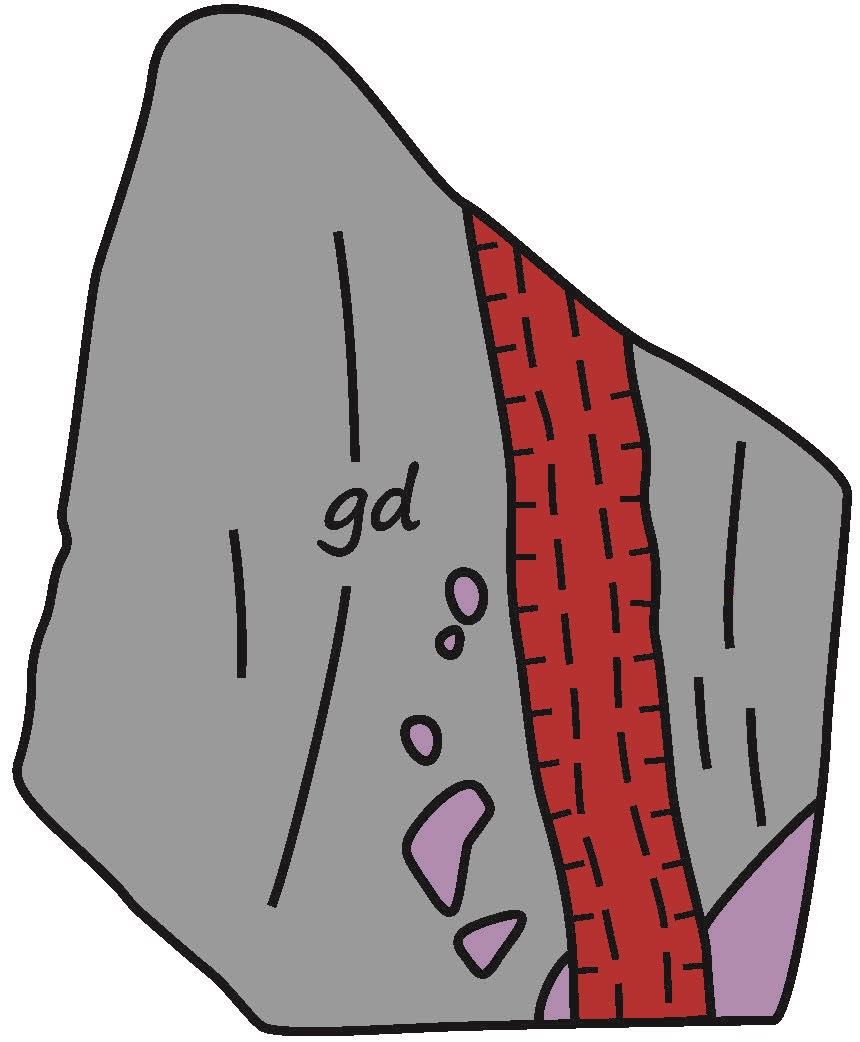
Figure 9b. Sketch of the Elves Chasm Specimen; gd indicates the lithology of the main pluton (granodiorite) shown in gray, older inclusions are in purple and the younger granitic dike is in red.
Illustration by Karl Karlstrom.
Challenges of Determining Numeric Ages of Sedimentary Rocks
Sedimentary units present a still different complexity in determining their best age. Sedimentary rocks are usually deposited over long time periods so a single number is technically not correct even though it is of use for characterizing ages of rock units. The Bass Formation was deposited as a lime mud in shallow seas and contains stromatolites, the oldest visible/macroscopic fossils in Grand Canyon (Figure 10). Its best age is 1,255 ± 2 million years ago based on a U-Pb radiometric age determination on a volcanic ash bed within this unit. But the Bass Formation is more than 328 ft (100 m) thick and undoubtedly took many million years to deposit.
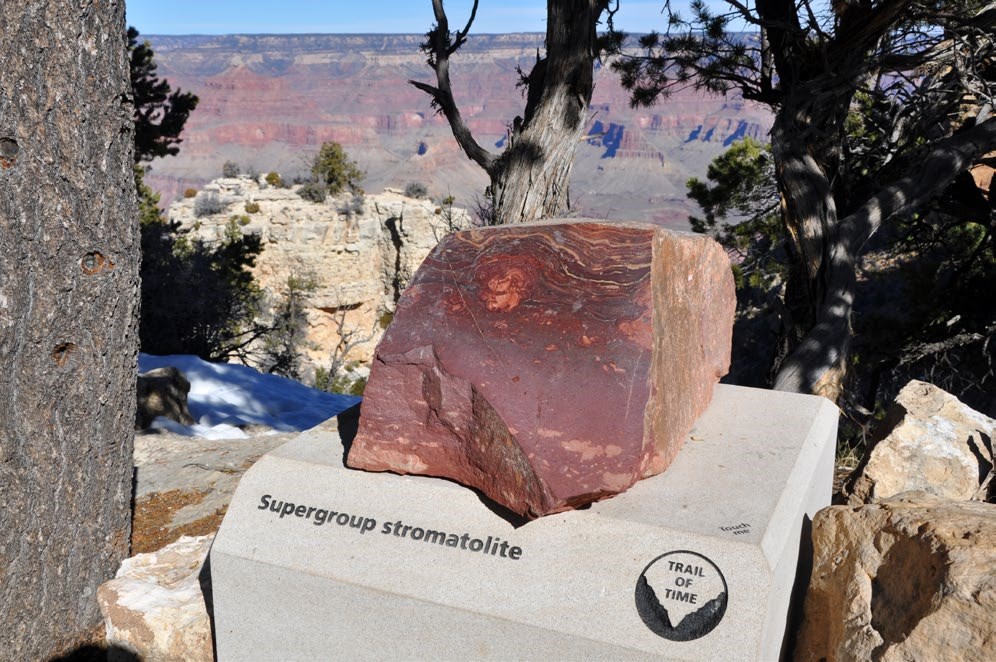
Figure 10a. Specimen of the Bass Formation on the Trail of Time. This rock was deposited as a lime mud and contains the oldest fossils (stromatolites) in Grand Canyon. An ash bed within this formation was dated at 1,255 ± 2 Ma.
NPS photo by Michael Quinn.
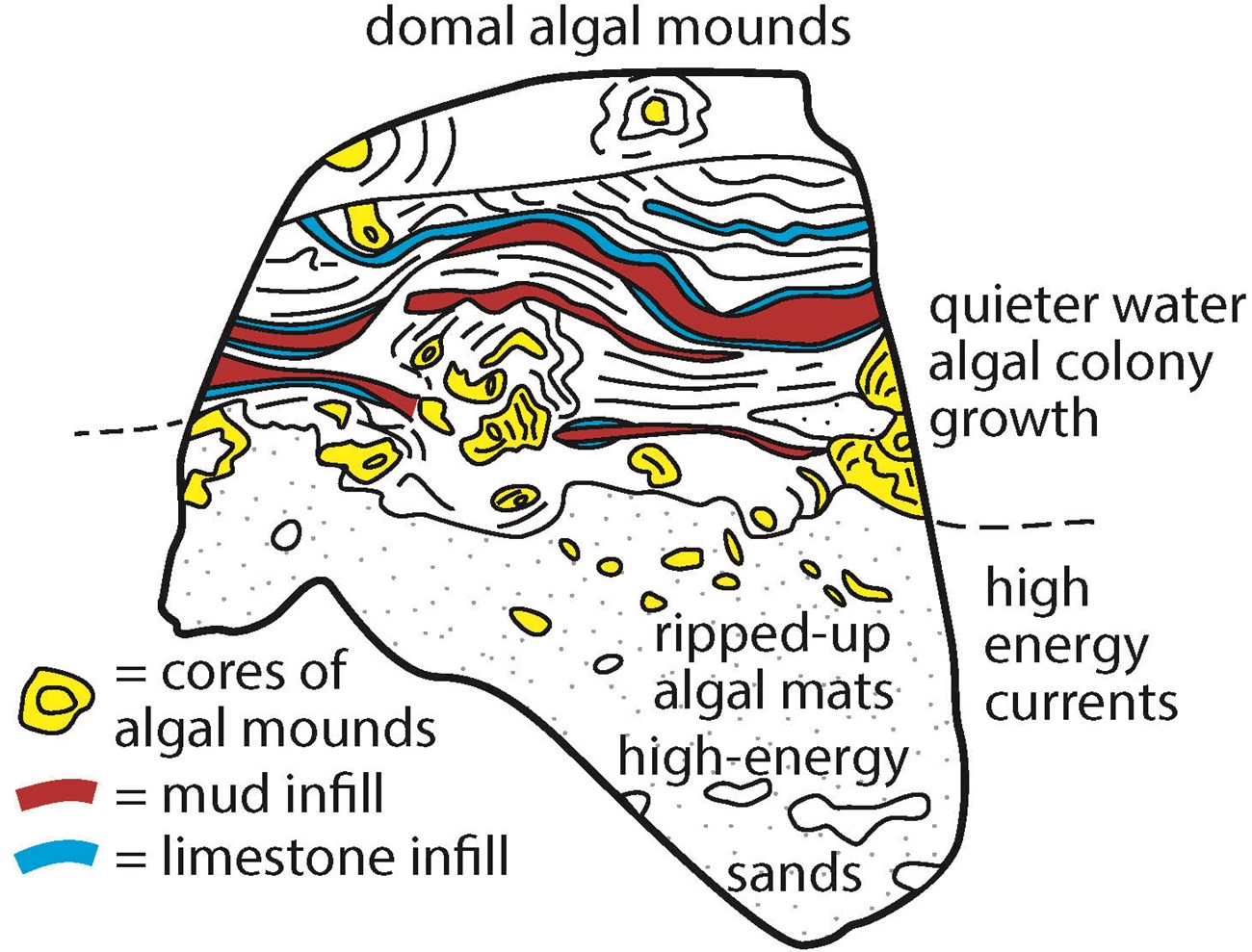
Figure 10. Sketch of the Bass Formation specimin on the Trail of Time.
Illustration by Karl Karlstrom.
Fossiliferous sedimentary rocks often have well-known stratigraphic ages although numeric ages are commonly not available. For example, the Redwall Limestone (Figure 11) contains a distinctive assemblage of fossils. These fossils and the use of fossil biozones and the International Stratigraphic Chart v 2020/01 indicate that the Redwall Limestone is late Early to Middle Mississippian in age (which is about 340 million years old). Again, the deposition of this unit likely occurred over a period of a few million years.
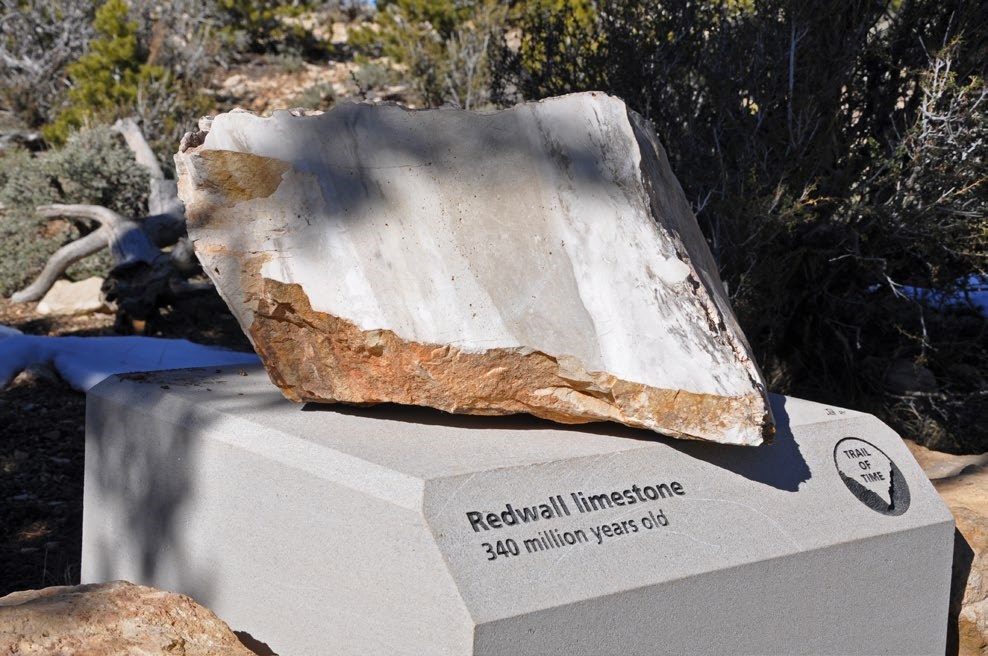
Figure 11. Redwall Limestone specimen on the Trail of Time.
NPS photo by Michael Quinn.
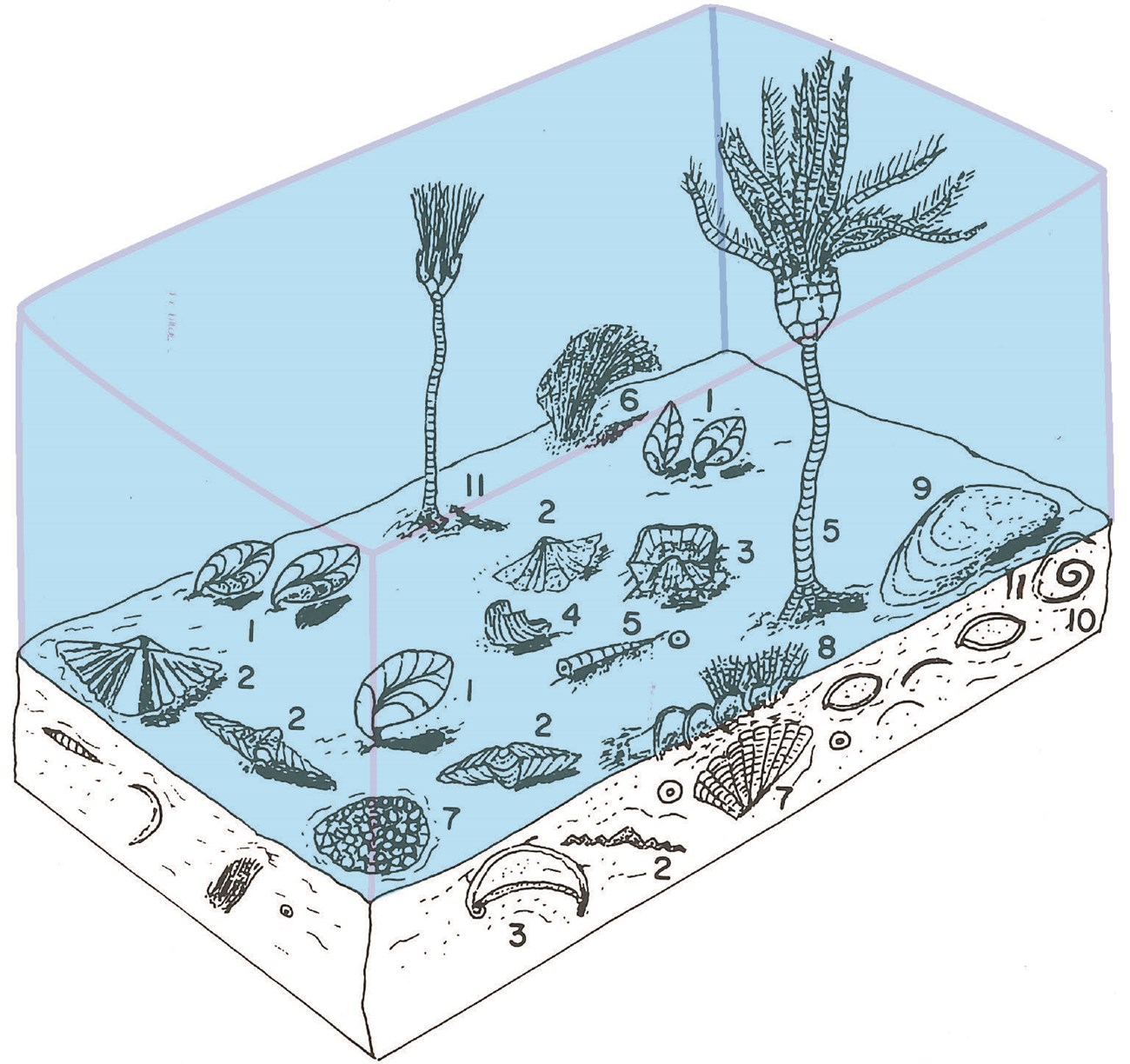
Figure 11b. Sketch of fossils found in Redwall Limestone specimen on the Trail of Time. Diverse marine fossils include crinoids (1,2), bryozoa colonies (6,8), bivalves (9), and snails (10) that help constrain its age.
Illustration modified from Stan Beus.
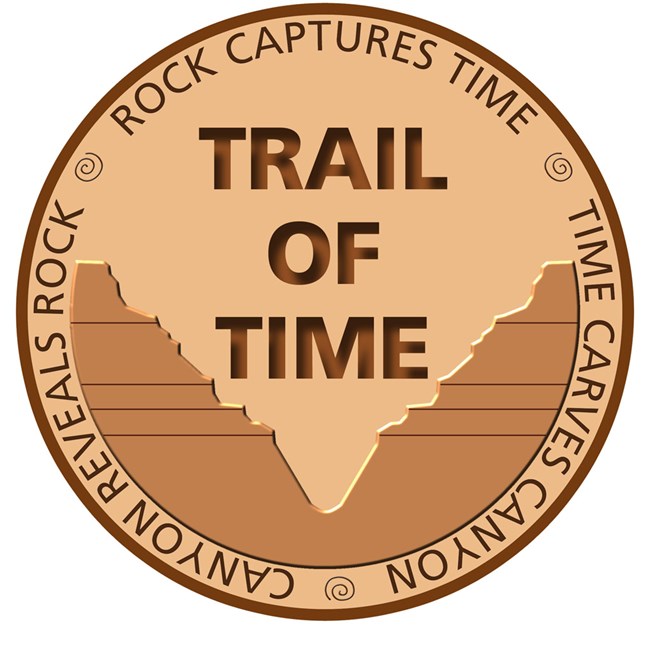
One portrayal of geologic time is shown in Figure 1. Rock Captures Time refers to the depth of geologic time, measured in billions of years, and the stories told by different rock units. Time Carves Canyon reminds us of the millions of years it took for the river and erosion to carve through rock to shape canyons and landscapes. Canyon Reveals Rock summarizes multiple time scales — the very old rocks exposed by the actively carving Colorado River in the walls of the relatively young Grand Canyon.
The Trail of Time
One prominent effort to make the geologic history of Grand Canyon and the age of the rocks exposed within it more relevant to the public is the Trail of Time, a geologic timeline exhibit near Grand Canyon Village (Figures 4 and 5). The Trail of Time follows the Rim Trail between Yavapai Geology Museum and Grand Canyon Village and affords spectacular vistas, interpretive panels, and has samples of Grand Canyon rocks to see and touch. Also, it is a memorable and accessible family hike.
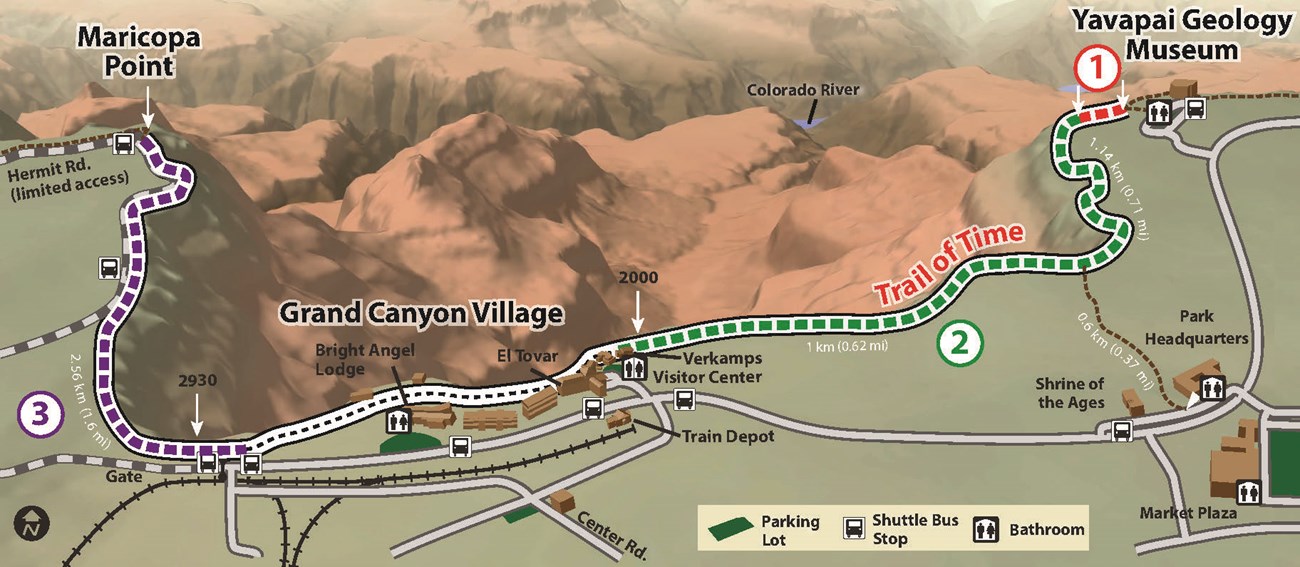
Figure 5. Perspective view of the Grand Canyon Village area on the South Rim of Grand Canyon. The Trail of Time exhibit extends from Yavapai Geology Museum to the Village, and then to Maricopa Point. The numbers and colors refer to segments of the Trail of Time: 1 = Million Year Trail; 2 = Main Trail of Time; 3 = Early Earth Trail.
Bronze markers set every meter (a long step) along the trail represent one million years of Earth’s history. The 2,000 steps between Yavapai Geology Museum and Grand Canyon Village cover the last 2,000 million (2 billion) years, encompassing Grand Canyon’s rock record. Rock specimens were collected along the river and brought up to be placed at their age (their “birthday”) along the timeline. The Early Earth Trail extends beyond the village to Maricopa Point and the age of the Earth at 4,560 million years ago.
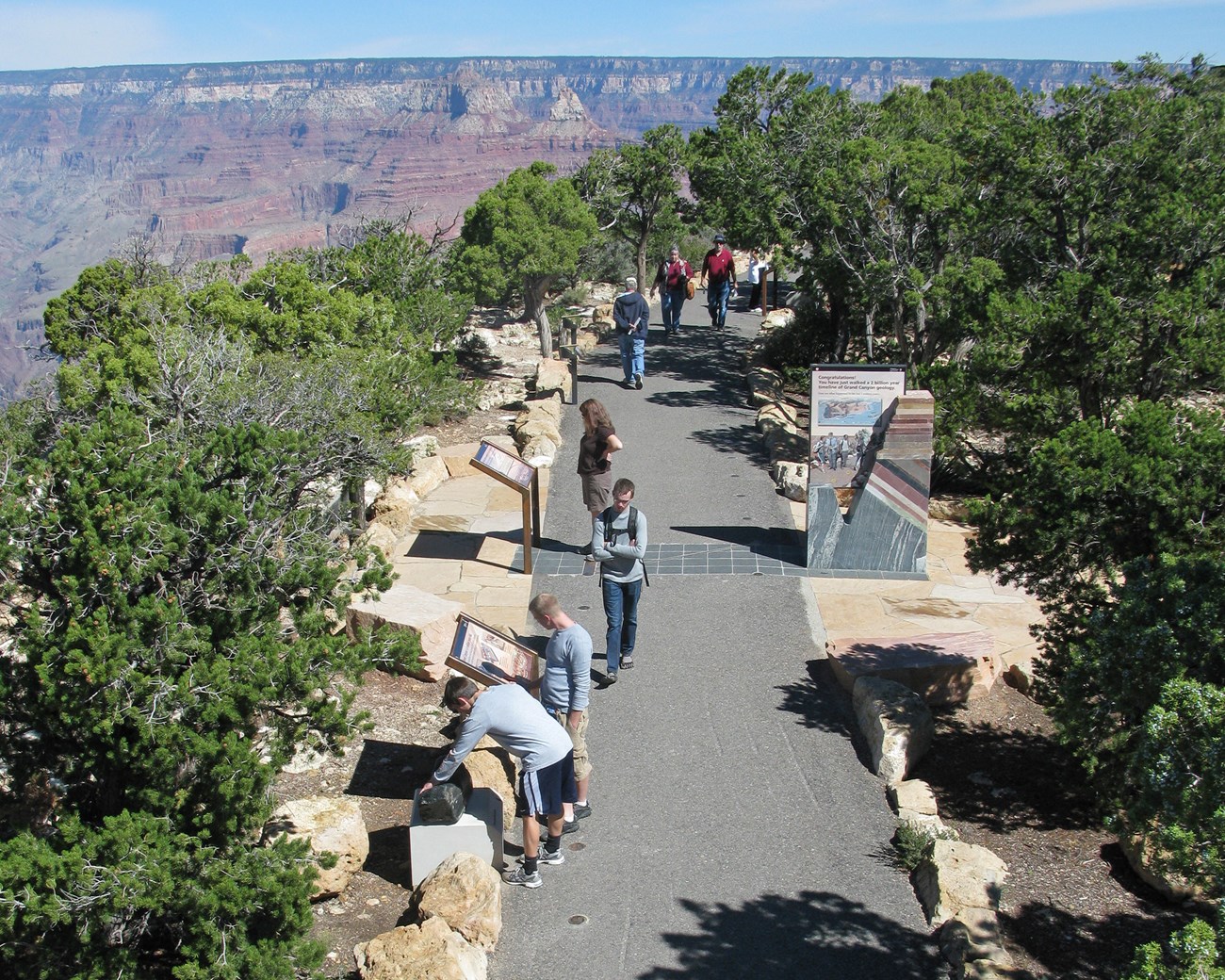
NPS photo by Michael Quinn.
The Trail of Time was funded by the National Science Foundation with in-kind support from Grand Canyon NP. It opened in 2010. The Trail of Time project was the culmination of 25 years of research on the geology of Grand Canyon and the age of its rocks by the Trail of Time team, and is still an active bridge between research advances and geoscience education.
Trail of Time Companion 2019
The Grand Canyon Trail of Time Companion, a book and walking guide to provide additional layers of information for visitors, was published in 2019. This recognizes the concept of multiple knowledge hierarchies that focuses on the learning journey of each visitor. Hence, the goal is to help each visitor move up the hierarchy from whatever their level of entry may be. The Companion also summarizes the making of the Trail of Time exhibit. And, in one section, the rock samples that are displayed along the trail provide a narration of Grand Canyon’s geologic history, told (as if) by the rocks themselves. The Companion incorporated new research on the age of Grand Canyon rocks, including revisions to the stratigraphy of the Grand Canyon Supergroup and the Paleozoic Tonto Group, as well as refinements to the ages and nomenclature of many rock units.
Previous Compilations of Numeric Ages
The first systematic compilation of best numeric ages was issued in 2005 in the then-Grand Canyon NP publication Nature Notes. While the authors did not conduct geologic research themselves, they extensively consulted with geoscientists investigating Grand Canyon’s geology and reviewed the technical literature in order to prepare their compendium. The Nature Notes compilation did not include specific ages for every rock unit exposed in Grand Canyon, but provided numeric ages or range of numeric ages for most of the canyon’s prominent units.
These numeric ages were also published in Park Science and Boatman’s Quarterly Review, a publication of the Grand Canyon River Guides. They were also presented to the public in park-produced publications and in ranger interpretive programs, and used elsewhere such as in the Yardstick of Geologic Time. The compilation was superseded by the National Park Service Natural Resources Report Telling Time at Grand Canyon National Park: 2020 Update and this series of web articles.
Learn More
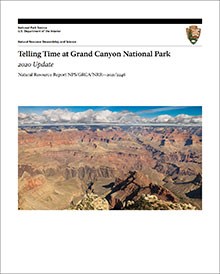
To learn more about the age of Grand Canyon’s rocks, please see:
Karlstrom, K., L. Crossey, A. Mathis, and C. Bowman. 2021. Telling time at Grand Canyon National Park: 2020 update. Natural Resource Report NPS/GRCA/NRR—2021/2246. National Park Service, Fort Collins, Colorado. https://doi.org/10.36967/nrr-2285173. [IRMA Portal]
Authors
- Dr. Karl Karlstrom is a Distinguished Professor of Geology at the University of New Mexico with a specialty in tectonics; he has researched Grand Canyon rocks of all ages over the past 35 years.
- Dr.Laurie Crossey is a Professor of Geology and Geochemistry at the University of New Mexico who has worked on Grand Canyon rocks and water issues over the past 20 years.
- Allyson Mathis is a Research Associate with the Northern Rockies Conservation Cooperative, and a geologist by training. Allyson worked for the National Park Service at Grand Canyon National Park from 1999 to 2013.
- Carl Bowman is a retired air quality specialist, formerly of Grand Canyon National Park, where he worked in various positions between 1980 and 2013.
References
-
Babcock, R. S. 1990. Precambrian crystalline core, in S. S. Beus and M. Morales, editors. Grand Canyon geology, first edition. Oxford University Press, Oxford, United Kingdom.
-
Billingsley, G. H., and S. S. Beus. 1985. The Surprise Canyon Formation, an Upper Mississippian and Lower Pennsylvanian (?) rock unit in the Grand Canyon, Arizona. U.S. Geological Survey, Washington, D.C. Bulletin 1605: A27–A33.
-
Breed, W.J., and Ford, T.D., 1973, Chapter Two-and-a-half of Grand Canyon history, or the Sixty Mile Formation: Plateau, v. 46, no. 1, p. 12-18.
-
Cohen, K. M., S. C. Finney, P. L. Gibbard, and J.-X. Fan. 2013; updated in 2020. The ICS International Chronostratigraphic Chart. Episodes 36: 199–204. Available at https://stratigraphy.org/icschart/ChronostratChart2020-01.pdf (accessed 01 Jun 2020).
-
Dehler, C., G. Gehrels, S. Porter, M. Heizler, K. Karlstrom, G. Cox, L. Crossey, and M. Timmons. 2017. Synthesis of the 780–740 Ma Chuar, Uinta Mountain, and Pahrump (ChUMP) groups, western USA: Implications for Laurentia-wide cratonic marine basins. Geological Society of America Bulletin 129(5–6): 607–624. doi: 10.1130/B31532.1.
-
Francischini, H., S. G. Lucas, S. Voight, L. Marchetti, V. L. Santucci, C. L. Knight, J. R. Wood, P. Dentzien-Dias, and C. L. Schultz. 2019. On the presence of Ichniotherium in the Coconino Sandstone (Cisuralian) of the Grand Canyon and remarks on the occupation of deserts by non-amniote tetrapods. Paläontologische Zeitschrift online: 119.
-
Gehrels, G. E., R. Blakey, K. E. Karlstrom, J. M. Timmons, S. Kelley, B. Dickinson, and M. Pecha. 2011. Detrital zircon U-Pb geochronology of Paleozoic strata in the Grand Canyon, Arizona. Lithosphere 3: 183–200. doi: 10.1130/L121.1.
-
Hawkins, D. P., S. A. Bowring, B. R. Ilg, K. E. Karlstrom, and M. L. Williams. 1996. U-Pb geochronologic constraints on Proterozoic crustal evolution. Geological Society of America Bulletin 108: 1167–1181.
-
Hintze, L. F. and B. J. Kowallis. 2009. Geologic History of Utah. Brigham Young University Geology Studies Special Publication 9, Provo, Utah.
-
Holland, M. E., K. E. Karlstrom, G. Gehrels, O. P. Shufeldt, G. Begg, W. L. Griffin, and E. Belousova. 2018. The Paleoproterozoic Vishnu basin in southwestern Laurentia: implications for supercontinent reconstructions, crustal growth, and the origin of the Mojave province: Precambrian Research 308: 1–17.
-
Ilg, B. R., K. E. Karlstrom, D. Hawkins, and M. L. Williams. 1996. Tectonic evolution of Paleoproterozoic rocks in Grand Canyon, Insights into middle crustal processes. Geological Society of America Bulletin 108: 1149–1166.
-
Karlstrom, K. E., S. A. Bowring, C. M. Dehler, A. H. Knoll, S. Porter, Z. Sharp, D. Des Marais, A. Weil, J. W. Geissman, M. Elrick, M. J. Timmons, K. Keefe, and L. Crossey. 2000. Chuar Group of the Grand Canyon: Record of breakup of Rodinia, associated change in the global carbon cycle, and ecosystem expansion by 740 Ma. Geology 28: 619–622.
-
Karlstrom, K. E., and L. J. Crossey. 2019. The Grand Canyon Trail of Time companion: Geology essentials for your canyon adventure. Trail of Time Press, Albuquerque, New Mexico.
-
Karlstrom, K. E., J. Hagadorn, G. G. Gehrels, W. Mathews, M. Schmitz, L. Madronich, J. Mulder, M. Pecha, D. Geisler, and L. J. Crossey. 2018. U-Pb dating of Sixtymile and Tonto Group in Grand Canyon defines 505–500 Ma Sauk transgression. Nature Geoscience 11: 438–443.
-
Karlstrom, K. E., S. S. Harlan, M. L. Williams, J. McLelland, J. W. Geissman, and K. I. Ahall. 1999. Refining Rodinia: Geologic evidence for the Australia–Western U.S. connection for the Proterozoic. GSA Today 9(10): 1–7.
-
Karlstrom, K. E., B. R. Ilg, M. L. Williams, D. P. Hawkins, S. A. Bowring, and S. J. Seaman. 2003. Paleoproterozoic rocks of the Granite Gorges. Pages 9–38 in S. S. Beus and M. Morales, editors. Grand Canyon geology, second edition. Oxford University Press, Oxford, United Kingdom.
-
Karlstrom, K. E., M. T. Mohr, M. Schmitz, F. A. Sundberg, S. Rowland, J. Hagadorn, J. R. Foster, L. J. Crossey, C. Dehler, and R. Blakey. 2020. Redefining the Tonto Group of Grand Canyon and recalibrating the Cambrian timescale. Geology 48: 425–430. doi: 10.1130/G46755.1.
-
Karlstrom, K., S. Semken, L. Crossey, D. Perry, E. D. Gyllenhaal, J. Dodick, M. Williams, J. Hellmich-Bryan, R. Crow, N. Bueno Watts, and C. Ault. 2008. Informal geoscience education on a grand scale: The Trail of Time exhibition at Grand Canyon. Journal of Geoscience Education 56: 354–361.
-
Karlstrom, K. E., and J. M. Timmons. 2012. Many unconformities make one “Great Unconformity” in J. M. Timmons and K. E. Karlstrom, editors. Grand Canyon geology: 2 billion years of Earth history. Geological Society of America Special Paper 489, Boulder, Colorado.
-
Lillie, Robert J. 2005. Parks and plates: The geology of our national parks, monuments, and seashores. W. W. Norton, New York, New York.Mathis, A. 2006. Grand Canyon yardstick of geologic time: A guide to the canyon’s geologic history and origin. Grand Canyon Association, Grand Canyon, Arizona, USA.
-
Mathis, A. and C. Bowman. 2005a. What’s in a number?: Numeric ages for rocks exposed within Grand Canyon. Nature Notes XXI(1). Grand Canyon National Park, Arizona.
-
Mathis, A. and C. Bowman. 2005b. What’s in a number?: Numeric ages for rocks exposed within Grand Canyon. Part 2. Nature Notes, v. XXI(2). Grand Canyon National Park, Arizona.
-
Mathis, A. and C. Bowman 2006a. The grand age of rocks Part 1— Numeric ages for rocks exposed within Grand Canyon. Boatman’s Quarterly Review 19(1):27–29. Grand Canyon River Guides, Flagstaff, Arizona. Available at https://www.gcrg.org/bqr/pdfs/19-1.pdf (accessed 01 Jun 2020).
-
Mathis, A. and C. Bowman 2006b. The grand age of rocks Part 2—Grand Canyon’s three sets of rocks. Boatman’s Quarterly Review: Grand Canyon River Guides. 19(2):19–23. Grand Canyon River Guides, Flagstaff, Arizona. Available at https://www.gcrg.org/bqr/pdfs/19-2.pdf (accessed 01 Jun 2020).
-
Mathis, A. and C. Bowman 2006c. The grand age of rocks Part 3—Geologic dating techniques. Boatman’s Quarterly Review 19(4):19–23. Grand Canyon River Guides, Flagstaff, Arizona. Available at https://www.gcrg.org/bqr/pdfs/19-4.pdf (accessed 01 Jun 2020).
-
Mathis, A. and Bowman, C. 2007. Telling Time at Grand Canyon National Park. Park Science, 24(2): 78–83. Available at https://irma.nps.gov/Datastore/DownloadFile/615879 (accessed 07 May 2020).
-
McKee, Edwin D. 1931. Ancient landscapes of the Grand Canyon region. Northland Press, Flagstaff, Arizona.
-
McKee, Edwin D. 1969. Stratified rocks of the Grand Canyon. In The Colorado River Region and John Wesley Powell. USGS Professional Paper 669-B. Washington DC. Available at https://pubs.usgs.gov/pp/0669/report.pdf (accessed 11 May 2020).
-
McKee, E. D. 1975. The Supai Group — Subdivision and nomenclature. U.S. Geological Survey Bulletin 1395-J, Washington, D.C , Washington, D.C.McKee, E. D., and C. E. Resser. 1945. Cambrian history of the Grand Canyon region. Carnegie Institution of Washington Publication 563.
-
Mohr, M.T., M.D. Schmitz, N.L. Swanson-Hysell, K.E. Karlstrom; F.A. Macdonald, M.E. Holland, Y. Zhang, N. Anderson. In review. High-Precision U-Pb geochronology links magmatism in the SW Laurentia Large Igneous Province and Midcontinent Rift.
-
Mulder, J. A., K. E. Karlstrom, K. Fletcher, M. T. Heizler, J. M. Timmons, L. J. Crossey, G. E. Gehrels, and M. Pecha. 2017. The syn-orogenic sedimentary record of the Grenville Orogeny in southwest Laurentia. Precambrian Research 294: 33–52.
-
National Park Service. 2017. Foundation Statement. Grand Canyon National Park. Grand Canyon, Arizona.
-
Perry, D. L. 2012. What makes learning fun? Principles for the design of Intrinsically motivating museum exhibits. AltaMira Press, Lanham, Maryland.
-
Powell, J. W. 1875. Exploration of the Colorado River of the West and its tributaries. Explored in 1869, 1870, 1871, and 1872, under the direction of the Secretary of the Smithsonian Institution. U.S. Government Printing Office, Washington, D.C., USA.
-
Rooney, A. D., J. Austermann, E. F. Smith, Y. Li, D. Selby, C. M. Dehler, M. D. Schmitz, K. E. Karlstrom, and F. A. Macdonald. 2018. Coupled Re-Os and U-Pb geochronology of the Tonian Chuar Group, Grand Canyon. Geological Society of America Bulletin 130(7–8): 1085–1098.
-
Santucci, V. L., and J. S. Tweet, editors. 2020. Grand Canyon National Park: Centennial paleontological resource inventory (non-sensitive version). Natural Resource Report NPS/GRCA/NRR—2020/2103. National Park Service, Fort Collins, Colorado.
-
Schuchert, Charles. 1918. The Cambrian of the Grand Canyon of Arizona. American Journal of Science (Series 4) 45: 368.
-
Shufeldt, O. P., K. E. Karlstrom, G. E. Gehrels, and K. Howard. 2010. Archean detrital zircons in the Proterozoic Vishnu Schist of the Grand Canyon, Arizona: Implications for crustal architecture and Nuna reconstructions. Geology 38: 1099–1102.
-
Spamer, Earle E. 1989. The development of geological studies in the Grand Canyon. Tryonia. Miscellaneous Publications of the Department of Malacology. The Academy of Sciences of Philadelphia No. 17. Philadelphia, Pennsylvania.
-
Timmons, J. M., and K. E. Karlstrom, editors. 2012. Grand Canyon geology: 2 billion years of Earth history. Geological Society of America Special Paper 489. Boulder, Colorado.
-
Timmons, J. M., K. E. Karlstrom, M. T. Heizler, S. A. Bowring, G. E. Gehrels, and L. J. Crossey. 2005. Tectonic inferences from the ca. 1255–1100 Ma Unkar Group and Nankoweap Formation, Grand Canyon: Intracratonic deformation and basin formation during protracted Grenville orogenesis. Geological Society of America Bulletin 117(11–12): 1573–1595.
-
Whitmeyer, S., and K. E. Karlstrom. 2007. Tectonic model for the Proterozoic growth of North America.Geosphere 3(4): 220–259.
Glossary
-
Absolute age: a numeric age in years. Numeric age is the preferred term.
-
Accuracy: measure of how close a numeric date is to the rock’s real age.
-
Angular unconformity: a type of unconformity or a gap in the rock record where horizontal sedimentary layers (above) were deposited on tilted layers (below). At Grand Canyon, horizontal layers of the Layered Paleozoic Rocks lie on top of the tilted rocks of the Grand Canyon Supergroup.
-
Basalt: a dark, fine-grained volcanic (extrusive igneous) rock with low silica (SiO2) content.
-
Biochron: length of time represented by a fossil biozone.
-
Carbonate: sedimentary rock such as limestone or dolostone largely composed of minerals containing carbonate (CO3-2) ions.
-
Contact: boundary between two bodies of rock or strata.
-
Daughter isotope: the product of decay of a radioactive parent isotope.
-
Detrital: pertaining to grains eroded from a rock that were transported and redeposited in another.
-
Dike: a wall-like (planar) igneous intrusion that cuts across pre-existing layering.
-
Diabase: a dark igneous rock similar in composition to basalt but with coarser (larger) grain size.
-
Disconformity: a type of unconformity or gap in the rock record between two sedimentary layers caused by erosion or nondeposition where the layers are parallel to one another.
-
Dolomite: the mineral calcium magnesium carbonate CaMg(CO3)2 that usually forms when magnesium-rich water alters calcium carbonate (CaCO3).
-
Dolostone: a rock predominantly made of dolomite.
-
Eon: longest subdivision of geologic time in the Geologic Timescale; for example, the Proterozoic Eon.
-
Era: second-longest subdivision of geologic time below eon in the Geologic Timescale; for example, the Paleozoic Era.
-
Epoch: fourth-longest subdivision of geologic time, shorter than a period and longer than a stage in the Geologic Timescale; for example, the Pleistocene Epoch.
-
Faunal succession: the change in fossil assemblages through time which has a specific, reliable order.
-
Foliation: tectonic layering in metamorphic rocks caused by parallel alignment of minerals due to compression.
-
Formation: the fundamental unit in stratigraphy and geologic mapping that consists of a set of strata with distinctive rock characteristics. Formations may consist of a single rock type (e.g., Tapeats Sandstone or Redwall Limestone), or a mixture of rock types (e.g. Hermit Formation, which includes sandstone, mudstone, and shale).
-
Fossil: evidence of life in a geologic context usually consisting of the remains or traces of ancient life.
-
Fossil biozone: stratigraphic unit defined by a distinctive assemblage of fossils.
-
Ga: giga annum: billion years; in this paper, our usage implies billion years before present (or ago) when used for numeric ages.
-
Gneiss: a high-grade metamorphic rock with strong foliation and light and dark bands of minerals.
-
Granite: a high silica (SiO2) pink to white intrusive igneous rock composed mainly of feldspar and quartz.
-
Granodiorite: a gray intrusive igneous rock composed of feldspar, quartz, biotite, and hornblende with less silica (SiO2) than granite.
-
Group: a sequence of two or more related formations, with a stratigraphic rank higher than formation; for example, the Chuar Group is made up of the Nankoweap, Galeros, and Kwagunt formations.
-
Igneous rock: a rock that solidified from molten material (magma or lava), either within the Earth (as an intrusive or plutonic rock) or after eruption onto the Earth’s surface (as an extrusive or volcanic rock).
-
Inclusion: a fragment of an older rock within a younger rock.
-
Index fossil: a fossil or assemblage of fossils that is diagnostic of a particular time in Earth history.
-
Intrusion: an igneous rock body that crystallized underground. Intrusions may have any size or shape; large ones are known as plutons, thin ones parallel to layering are known as sills, and thin ones that cut across layering are called dikes.
-
Isotope: one of the forms of a chemical element (with the same atomic number) that contains a different number of neutrons.
-
Lateral continuity: a geologic principle that sedimentary rocks extend laterally, and that if they are now separated due to erosion, they were once laterally continuous; for example, the Kaibab Formation on the South Rim is laterally continuous with the Kaibab Formation on the North Rim.
-
Lava: molten rock erupted onto the Earth’s surface.
-
Ma: mega annum: million years; in this paper, our usage implies million years before present (or ago) when used for numeric ages.
-
Magma: molten or partially molten rock material formed within the Earth.
-
Member: a subdivision of a formation, usually on the basis of a different rock type or fossil content; for example, the Hotauta Conglomerate is a member of the Bass Formation.
-
Metamorphic rock: a rock formed by recrystallization under intense heat and/or pressure, generally in the deep crust.
-
Monadnock: a bedrock island that sticks above the general erosion level.
-
Nonconformity: an unconformity or gap in the rock record where sedimentary layers directly overlie older and eroded igneous or metamorphic rocks.
-
Numeric age: age of a rock in years (sometimes called absolute age).
-
Numeric age determination: measurement of the age of a rock in years, often through the use of radiometricdating techniques.
-
Orogeny: mountain building event, usually in a collisional tectonic environment.
-
Parent isotope: the radioactive isotope that decays to a daughter isotope.
-
Pegmatite: a type of intrusive igneous rock usually of granitic composition with large crystal size.
-
Period: third-longest subdivision of geologic time shorter than an era and longer than an epoch in the Geologic Timescale; for example, the Permian Period.
-
Plate tectonics: theory that describes the Earth’s outer shell as being composed of rigid plates that move relative to each other causing earthquakes, volcanism, and mountain building at their boundaries.
-
Pluton: large intrusion of magma that solidified beneath the Earth’s surface.
-
Precambrian: the period of time before the Cambrian Period that includes the Proterozoic, Archean, and Hadean eons and represents approximately 88% of geologic time.
-
Precision: measure of the analytical uncertainty or reproducibility of an age determination.
-
Proterozoic: geologic eon dominated by single-celled life extending from 2,500 to 541 million years ago; divided into the Paleoproterozoic (1,600–2,500 Ma), Mesoproterozoic (1,000–1,600 Ma), and Neoproterozoic (541–1,000 Ma) eras.
-
Radioactive decay: the process by which the nuclei of an unstable (radioactive) isotope lose energy (or decay) by spontaneous changes in their composition which occurs at a known rate for each isotope (expressed as a half life); for example, the parent uranium (238U) isotope decays to the daughter lead (206Pb) isotope with a half life of 4.5 billion years.
-
Radiometric dating: age determination method that uses the decay rate of radioactive isotopes and compares the ratio of parent and daughter isotopes within a mineral or rock to calculate when the rock or mineral formed.
-
Regression: geologic process that occurs when the sea level drops relative to the land level; for example, by sea level fall and/or uplift of the land, causing the withdrawal of a seaway from a land area.
-
Relative time: the chronological ordering of a series of events.
-
Rift basin: a basin formed by stretching (extension) of the Earth’s crust. Rift basins are linear, fault-bounded basins that can become filled with sediments and/or volcanic rocks.
-
Rodinia: a Neoproterozoic supercontinent that was assembled about 1.0 Ga (during Unkar Group time) and rifted about 750 Ma (during Chuar Group time).
-
Sedimentary rock: a rock composed of sediments such as fragments of pre-existing rock (such as sand grains), fossils, and/or chemical precipitates such as calcium carbonate (CaCO3).
-
Schist: a metamorphic rock with platy minerals such as micas that have a strong layering known as foliation or schistosity.
-
Silica: silicon dioxide (SiO2), a common chemical “building block” of most major rock-forming minerals, either alone (i.e., as quartz) or in combination with other elements (in clays, feldspars, micas, etc.).
-
Sill: a sheet-like igneous intrusion that is parallel to pre-existing layering.
-
Snowball Earth: a hypothesis that the Earth’s surface became completely or mostly frozen between 717 and 635 million years ago.
-
Stage: a short subdivision of geologic time in the Geologic Timescale often corresponding to the duration of a fossil assemblage.
-
Stratigraphic age: the era, period, epoch, or stage a rock is assigned to based on its fossil biozones or numeric age.
-
Stratigraphy: the study of layered rocks (strata), which usually consist of sedimentary rock layers, but may also include lava flows and other layered deposits.
-
Stromatolite: a fossil form constructed of alternating layers (mats) of microbes (algal or bacterial) and finegrained sediment.
-
Subduction zone: a plate boundary where two plates converge and one sinks (subducts) beneath the other.
-
Supergroup: a sequence of related groups, with a higher stratigraphic rank than group; for example, the Grand Canyon Supergroup consists of the Unkar and Chuar groups.
-
Superposition: principle of geology that the oldest layer in a stratigraphic sequence is at the bottom, and the layers get progressively younger upwards.
-
Tectonics: large-scale processes of rock deformation that determine the structure of Earth’s crust and mantle.
-
Trace fossil: a sign or evidence of past life, commonly consisting of fossil trackways or burrows.
-
Transgression: a movement of the seaway across a land area, flooding that land area because of a relative sea level rise and/or land subsidence.
-
Travertine: calcium carbonate (CaCO3) precipitated by a spring; most travertine deposits also contain some silica.
-
Unconformity: a rock contact across which there is a time gap in the rock record formed by periods of erosion and/or nondeposition.
-
Volcanic ash: small particles of rock, minerals, and volcanic glass expelled from a volcano during explosive eruptions. Volcanic ash may be deposited great distances (even hundreds of miles or kilometers) from the volcano in especially large eruptions.
-
Yavapai orogeny: mountain building period that occurred approximately 1,700 million years ago when the Yavapai volcanic island arc collided with proto-North America.
-
Zircon: a silicate mineral (ZrSiO4) that often forms in granite and other igneous rocks and incorporates uranium atoms, making it useful for radiometric dating.
Photos and Illustrations
Related Links
-
Grand Canyon National Park (GRCA), Arizona—[GRCA Geodiversity Atlas] [GRCA Park Home] [GRCA npshistory.org]
Last updated: March 12, 2024

